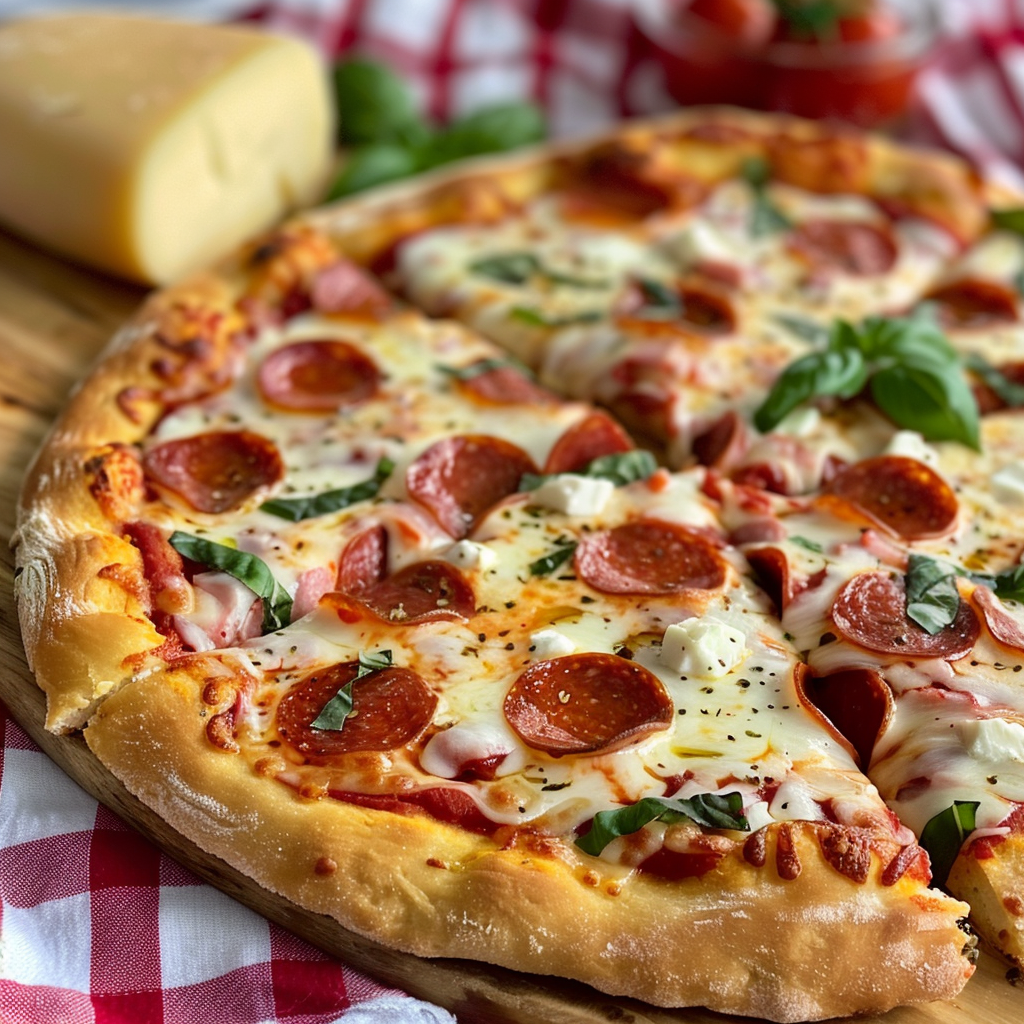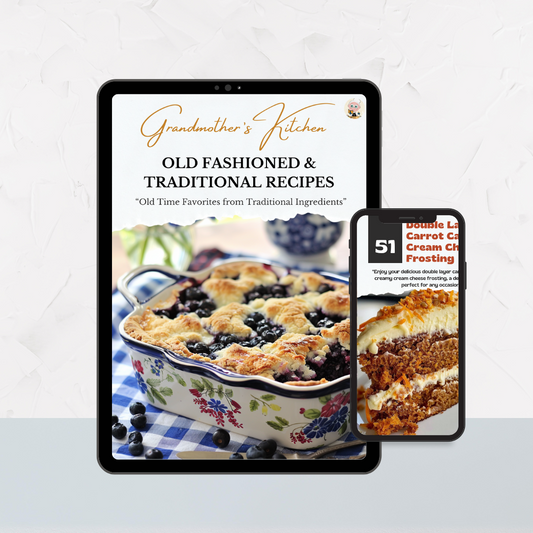Easy Homemade Pizza Recipe: Perfect Crust and Toppings for Family Pizza Night

Share
Pizza's Are Comfort Fun Food and You Can Make The Crust Or Buy Pre-Made
I used to think that making pizza meant you had to start from scratch with everything, including the dough. But over time, I’ve learned that it’s okay to take shortcuts when you need to, especially if it means getting to enjoy a homemade pizza with your family. Store-bought pizza dough is one of those conveniences that I’ve grown to appreciate—it saves time, and honestly, it still makes for a delicious pizza. Sometimes, we’re too hard on ourselves, thinking that everything has to be made from scratch to be good. But the truth is, the most important thing is gathering around the table, sharing the experience, and having fun with your loved ones. Whether you’re rolling out your own dough or using a pre-made one, making pizza at home can be a fun event. Everyone can get involved, from choosing toppings to assembling their own pizzas. It’s less about perfection and more about enjoying the moment together.
Did You Know?
History of Pizza Pans: The use of pizza pans has evolved alongside the popularity of pizza itself. While traditional Neapolitan pizzas are cooked in wood-fired ovens, modern kitchens use various tools to achieve similar results. Pizza pans, made from aluminum or steel, provide an accessible way to bake pizzas at home, offering even heat distribution and ease of use. This method allows for a crispy crust without the need for specialized equipment, making homemade pizza more approachable and versatile for cooks everywhere.
Yield: 4 servings
Ingredients:
- 1 pound pizza dough (store-bought or homemade, see recipe below)
- 1 cup pizza sauce
- 2 cups shredded mozzarella cheese
- 1/2 cup pepperoni slices (or any preferred toppings)
- 1 tablespoon olive oil
- 1 teaspoon dried oregano
- Fresh basil leaves (optional)
Instructions:
Prepare the Pizza Pan:
Preheat your oven to 475°F (245°C). Lightly grease your pizza pan with olive oil.
Personal Tip: Preheating the oven is essential to get that perfect crispy crust. I always make sure to give the oven a few extra minutes to fully heat up, especially when making pizza.
Prepare the Dough:
On a lightly floured surface, roll out the pizza dough to fit the size of your pizza pan.
Personal Tip: When rolling out the dough, try to maintain an even thickness to ensure it cooks uniformly.
Assemble the Pizza:
Place the rolled-out dough onto the prepared pizza pan. Spread the pizza sauce evenly over the dough, leaving a small border around the edges. Sprinkle the shredded mozzarella cheese over the sauce and add the pepperoni slices (or any other toppings you prefer). Sprinkle dried oregano over the top.
Personal Tip: When spreading the pizza sauce, leave a small border around the edges to prevent the sauce from spilling over during baking.
Bake the Pizza:
Place the pizza pan in the oven and bake for 12-15 minutes, or until the crust is golden brown and the cheese is bubbly and slightly browned.
Personal Tip: Keep an eye on the pizza during the last few minutes of baking to prevent overcooking.
Serve:
Remove the pizza from the oven and let it cool for a few minutes. Use a pizza cutter to slice and serve, garnished with fresh basil leaves if desired.
Personal Tip: Let the pizza cool for a few minutes before slicing to make it easier to handle.
Nutritional Information (Per Serving):
Calories: 400 | Protein: 18g | Carbohydrates: 36g | Sugars: 4g | Total Fat: 18g | Saturated Fat: 8g | Sodium: 900mg | Fiber: 2g
Quick and Easy Pizza Dough Recipe
Yield: 1 pizza crust (enough for the recipe above)
Ingredients:
- 2 1/4 teaspoons active dry yeast (1 packet)
- 1 teaspoon sugar
- 1 cup warm water (110°F or 45°C)
- 2 1/2 cups all-purpose flour
- 2 tablespoons olive oil
- 1 teaspoon salt
Instructions:
Activate the Yeast:
In a small bowl, dissolve the yeast and sugar in the warm water. Let it sit for about 5 minutes, until the mixture becomes frothy.
Personal Tip: Ensure the water is warm but not hot to avoid killing the yeast.
Mix the Dough:
In a large mixing bowl, combine the flour and salt. Make a well in the center and add the yeast mixture and olive oil. Stir with a wooden spoon until the dough begins to come together.
Personal Tip: Gradually add the wet ingredients to the dry mixture to avoid lumps.
Knead the Dough:
Turn the dough out onto a lightly floured surface. Knead for about 5-7 minutes, until the dough is smooth and elastic.
Personal Tip: If the dough is sticky, add a little more flour, but avoid adding too much to keep the dough soft.
Let the Dough Rise:
Place the dough in a lightly oiled bowl, turning it to coat all sides with oil. Cover with a clean kitchen towel and let it rise in a warm place for about 30 minutes, or until doubled in size.
Personal Tip: For a faster rise, place the dough in a warm, draft-free area like an oven with just the light on.
Prepare for Baking:
Punch down the dough to release any air bubbles. Roll out the dough on a lightly floured surface to fit your pizza pan.
Personal Tip: After punching down the dough, let it rest for a few minutes before rolling it out to make it easier to shape.
Kitchen Tips, Great Ideas, How to Save Money
-
Choosing the Dough: Store-bought pizza dough is convenient and saves time. Look for it in the refrigerated section of your grocery store. For a budget-friendly option, you can make your own dough at home with simple ingredients like flour, yeast, water, and salt. Homemade dough can be made in batches and frozen for later use.
-
Preheating the Pan: Preheating the pizza pan in the oven for a few minutes before placing the dough on it can help achieve a crispier crust. This step ensures the dough starts cooking immediately upon contact with the hot pan.
-
Topping Variations: Customize your pizza with a variety of toppings. Vegetables like bell peppers, mushrooms, onions, and olives are healthy and add great flavor. For a protein boost, consider adding cooked sausage, grilled chicken, or bacon. Mixing different cheeses like cheddar, Parmesan, and feta can also enhance the taste.
-
Seasoning the Pan: If your pizza pan is not non-stick, lightly grease it with olive oil before adding the dough. This will prevent sticking and make it easier to remove the pizza after baking.
-
Leftover Tips: Leftover pizza can be reheated in the oven or on the stovetop to maintain its crispiness. Simply heat a skillet over medium heat, place the pizza slices in the skillet, cover with a lid, and cook for a few minutes until heated through. This method prevents the crust from becoming soggy, unlike microwaving.
-
Serving Suggestions: Pair your pizza with a fresh salad for a balanced meal. A simple side salad with mixed greens, cherry tomatoes, cucumbers, and a light vinaigrette complements the richness of the pizza. Garlic bread or cheesy breadsticks also make great sides.
-
Storage and Reheating: Store leftover pizza slices in an airtight container in the refrigerator for up to three days. Reheat in the oven to retain the crispy crust. For longer storage, wrap individual slices in aluminum foil and freeze. Reheat directly from frozen in the oven.
-
Cost-Saving Tips: Buy toppings in bulk or when on sale to save money. Items like cheese, pepperoni, and vegetables can be portioned out and frozen for future use. Making your own pizza sauce with canned tomatoes, garlic, and herbs is often cheaper and healthier than store-bought versions.
-
Creative Variations: Experiment with different pizza styles. Try a white pizza with ricotta and spinach, a BBQ chicken pizza with BBQ sauce and red onions, or a breakfast pizza with scrambled eggs and bacon. The possibilities are endless, and experimenting can keep your meals exciting.
-
Eco-Friendly Cleaning: Clean your pizza pan with warm water and a brush. Avoid using harsh detergents, as they can damage the pan’s surface. For stuck-on food, soak the pan in warm water and baking soda before scrubbing gently. Dry the pan thoroughly to prevent rust and maintain its quality.
What About The Baking Process?
When it comes to baking pizza at home, the type of pan or baking surface you use can make a big difference. Traditional pizza stones are excellent for achieving a crispy, evenly cooked crust. They absorb moisture and distribute heat evenly, mimicking the effects of a wood-fired oven. If you don’t have a pizza stone, a heavy-duty pizza pan works well, especially when preheated. There are also perforated pizza pans that allow for better air circulation, which helps the crust crisp up. For those who love pizza enough to invest in the experience, small countertop pizza ovens can deliver that pizzeria-style crust in a fraction of the time. No matter what you use, the key is to get it hot before adding your pizza, so the crust cooks evenly and quickly, giving you that perfect balance of chewy and crispy.


